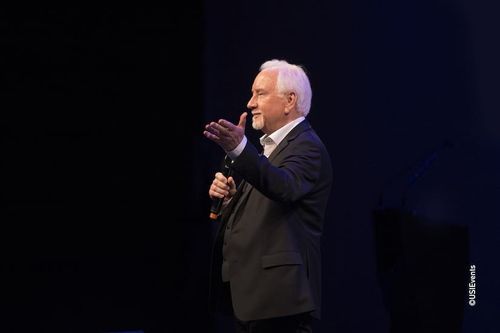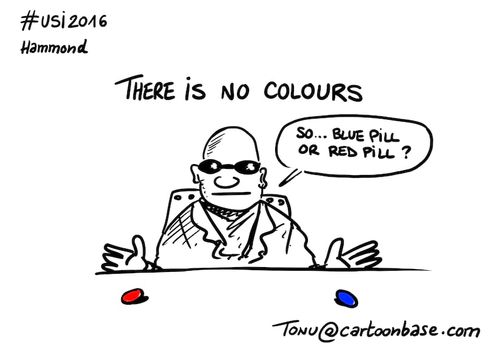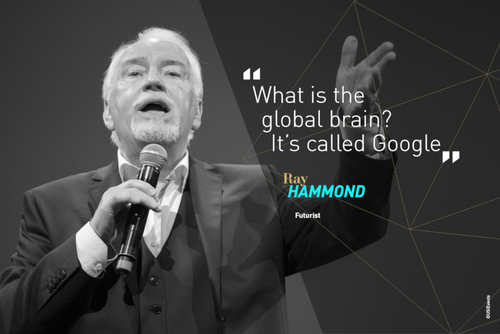Ray Hammond - Homo Virtualis: the virtual ape in virtual reality
Ray Hammond is a world renowned futurist. In his USI 2016 presentation, he demonstrates to what extent humans are virtual creatures, and shows how we are lacking language for the technological future. A language which would allow us to envisage humanity's future, and to foresee what impacts technology could have on us.
Invoking Winston Churchill "The farther backward you can look, the farther forward you can see", Ray Hammond begins by reminding us of our far past and the ancestral roots of our virtuality. In his view, everything started when our ancestors, homo sapiens, started standing on two feet. Although we don't know why some groups starting walking on two feet, we do know what impacts this has had on the development of our species. With gravity's pull, the bones at the base of our skull moved back and made room for the brain to grow. The larynx also moved back, freeing up more space for it to grow longer and to produce sounds. The combination of a bigger brain and larynx is the main reason for the appearance of language, which is to say the identification of objects and individuals using abstract sounds. For Ray Hammond, virtual is anything that has power or effectiveness without being physically present. Retaining this Latin etymology, the world around us, that we have named, is indeed virtual.
4 virtual creations which have made the world what it is today
He then recounts how millions of languages have appeared and disappeared, as each tribe has invented its own sounds for first names, the sky and the earth: giving meaning to things, but only within a given group. He then jumps ahead in time to bring us to Mesopotamia, as agriculture is being invented. It is around then that humans invented four virtual creations which have made the world what it is today:
- Alphabetic writing: using individual characters to represent sounds made it possible to form words and grammar, and especially to leave traces for future generations. Such recording writing is indeed virtual: it is nothing more than signs on a stone or a papyrus.
- The notions of date and time: whereas the sun's cycle is real, dividing its natural cycle into minutes is virtual. The trick is to agree on a virtual concept that others can understand, e.g. for setting an appointment at a given hour.
- Mathematics: for Ray Hammond, this is the most elegant way to describe and measure the world. While its ways of measuring are not virtual, measurement is.
- Money: although value exists, money is not value. Food, water, shelter, warmth, energy all have value. The rest of value is virtual, created by society. Whether it be through a stone, gold or a banknote, it is our shared acceptance which establishes value.
He goes on to give other examples of our virtuality. Books are also virtual in the sense that they use language to store and distribute information, and cannot be read without understanding the language they are written in. Similarly, navigation is a virtual invention, through its references to latitude and longitude, which are purely conventional.
"We are living in our own form of virtual reality"
Hammond goes even farther in his theory, insisting on the fact that we have no language for the future. If one examines past inventions and the associated vocabulary, one realizes that the words for the inventions were coined after the fact: projectors used to be magic lanterns, cars were horseless buggies, locomotives were iron horses, people spoke of flying machines...
Just as the word smartphone gives no indication of what this innovation will represent for the future, the only way we have to name a car without a driver is by negation.
Projecting into the future, Hammond asserts that smartphones will seem totally obsolete compared to contact lenses, ocular implants and control rings. For him, virtual reality is only just beginning. He actually calls it "vomitive reality" given its drawbacks, namely its lack of fluidity. But Hammond insists: "we are living in our own form of virtual reality". With the improvement of the virtual reality technology, the border with our inner world will become hard to define. For him the only difference is that the technology will be controllable. The rendition will be no different, making the technology completely addictive.
To conclude, Ray Hammond brings us to 2030, to give us an idea of what life is like in those times. Smartphone software assistants will have become very useful, they will finally have understood our language in context - which is much harder than winning a game of go! We will be in command of our own corporal network, and in relation with a global brain, which we used to call Google! Virtual reality will be part of our experiences and we won't even realize it.
This means that we are beginning the most incredible period of our humanity. Ray Hammond concludes with some food for thought: _"_Of course virtual reality is the future, but is it so different from the virtual reality of our lives today?".


